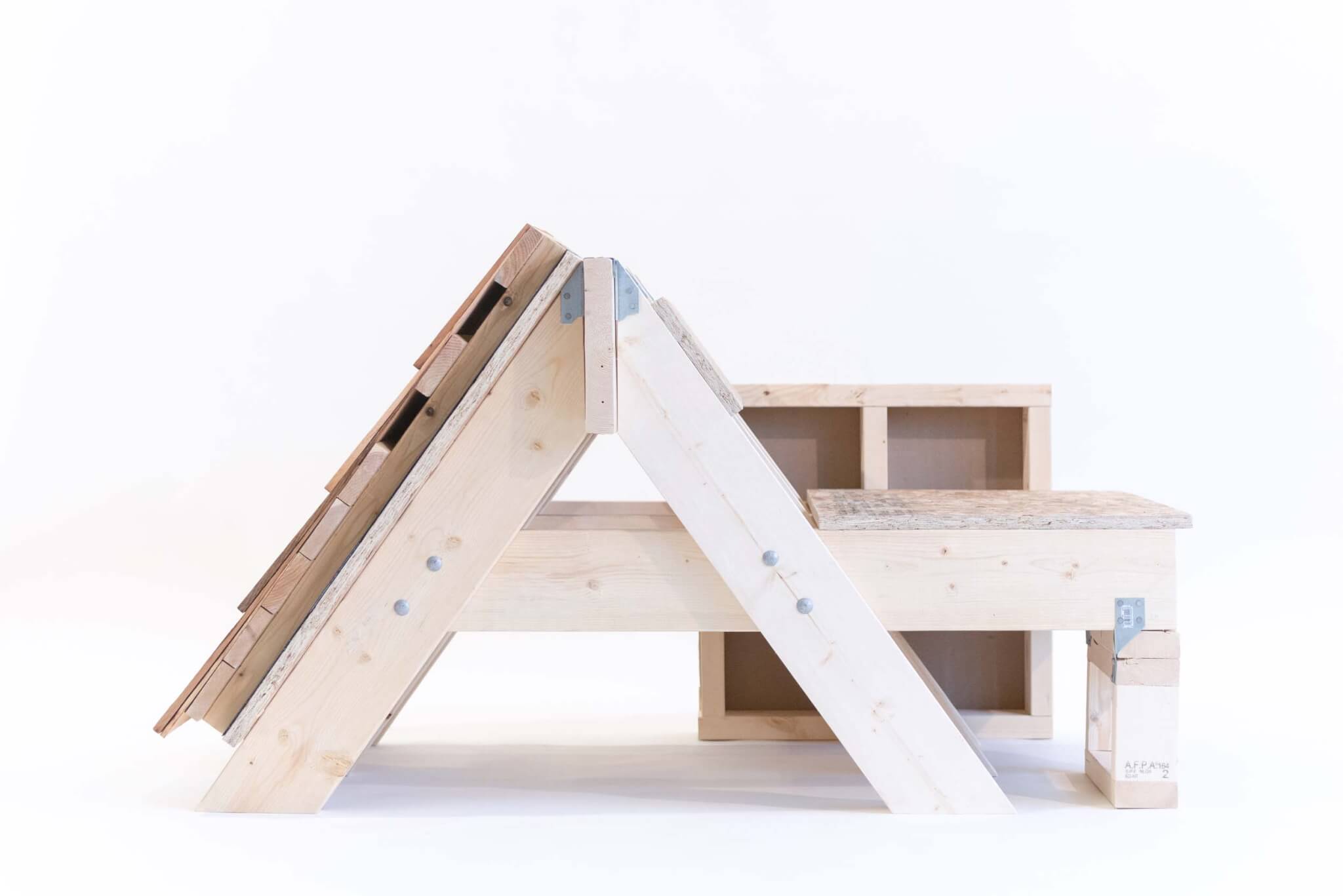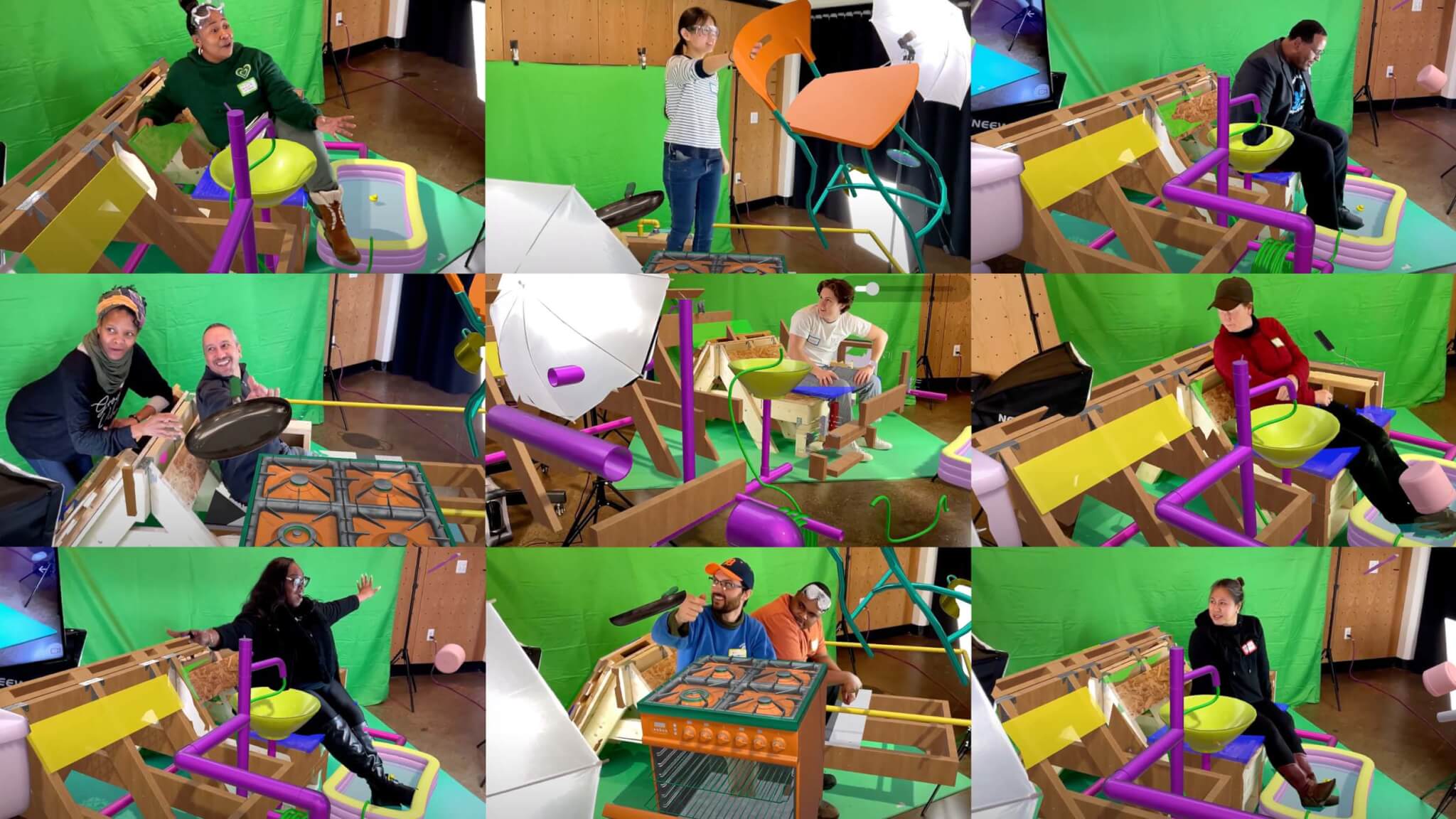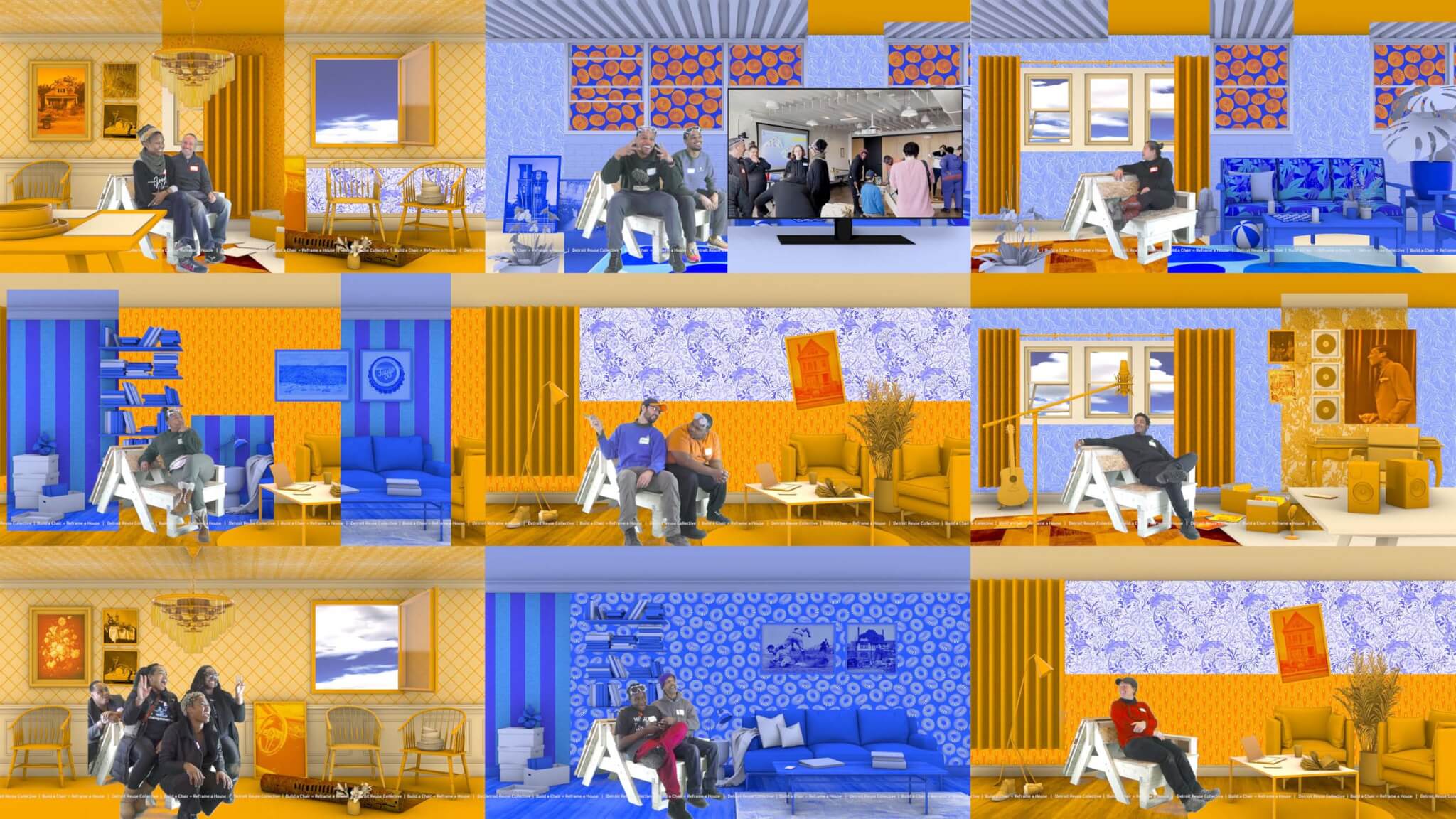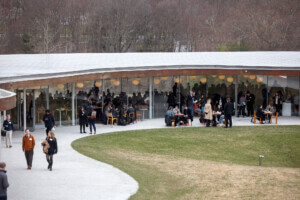There are nearly 7,000 structures undergoing a shared process of repair in the city of Detroit. This number reflects the amount of previously abandoned houses people have purchased from the Detroit Land Bank Authority (DLBA) and are currently renovating into livable homes under the guidelines of the DLBA’s compliance program. Within this milieu of construction, Detroiters have created incredible formal and informal networks to support a collective ethos of reuse, such as DIY YouTube channels, material salvage centers, and online Facebook resource groups totalling thousands of members.
Inspired by this ethos, we formed Detroit Reuse Collective (DRC) to contribute to this movement. Our work at 1+1+ Architects and EXTENTS focuses on using architecture and digital media to build relationships as opposed to formulating our offices’ work as a business exchange between experts and clients. Our collaboration through DRC furthers this work by supporting residents rebuilding their DLBA homes, an exciting yet daunting process that requires adherence to a compliance schedule. DRC is a workshop-incubator that shepherds research and empirical knowledge to support the community in ways similar to what we observed already happening across Detroit. In contrast to singular top-down solutions, we are seeking collective agency in collaboration with innumerable individual actors who are working to improve the city’s material condition from the ground up. As a first instance of this effort, Detroit Reuse Collective initiated Build a Chair = Reframe a House, a workshop designed for Detroit residents renovating DLBA houses.

In designing the workshop, we sought to mirror the way we see architecture as a means to build relationships. Build a Chair = Reframe a House allowed us to bring in community partners who provided resources for reuse in Detroit to support participants. Carhartt Workshop Tool Bench, an outreach effort of the Carhartt Flagship that offers free tool rentals and construction advice, provided space and tools. The Architectural Salvage Warehouse of Detroit, a collective of builders and makers that disassembles houses and refashions the salvaged materials into new building parts, offered residents the opportunity to source their homewares with gift cards. The Detroit Land Bank Authority, which sells the houses residents are renovating, sent representatives to meet participants and answer their questions. The University of Michigan provided the financial and institutional support for the workshop through its Engage Detroit initiative, connecting both instructors and students to on-the-ground efforts in Detroit. The workshop, designed through lessons learned from the often overlooked yet impactful movement of residents renovating houses in Detroit, in turn becomes a template for collective agency.
On Saturday, February 4, 2023, twenty-three participants and members of the rebuilding community gathered in the meeting room of the Carhartt Workshop on Cass Avenue in Midtown Detroit. They were greeted with a curious assemblage of building materials, construction tools, green screens, animations, food, and refreshments. Soon, the room was buzzing with activity as the participants developed work through two exercises: HOUSE-CHAIR and HOUSE-WORLDS.
HOUSE-CHAIR
Architects have historically used the chair as a design object to explore compositional and construction ideas without the pressures of building at the architectural scale and speed. When Gerrit Rietveld developed his Red Blue Chair, he valued the intersection of vertical and horizontal lines as much as standard lumber sizes and simplicity of construction—similar to how he approached architecture. His hope was that through its standardized parts and ease of assembly that Red Blue Chair could be a mass-produced design object. We developed HOUSE-CHAIR to bring this history of chair design into a workshop format that also teaches basic American home framing and finishing skills through its assembly.

The American framing system’s sheer versatility and scalability makes it daunting, but the system was invented to enable a group of people with basic tools (a hammer and nails) and materials (light-weight wood framing) to build entire neighborhoods. HOUSE-CHAIR, an agglomeration of Detroit home fragments, teaches Detroiters how to frame and finish the floor, walls and roof of a home through its construction while formally representing the construction systems of an entire home. A Cedar Shake & Shingle Bureau roof assembly becomes the chair back, a standard OSB flooring system is its seat, and a gypsum wall doubles as an armrest.
By incorporating the basic tools, standard lumber sizes, and material assemblies of American framing construction at a 1:1 scale, workshop participants focused on the details and construction methods of assembly, a creative and technical knowledge scalable beyond the workshop. Kristine Patnugo, a workshop participant, found it “interesting and approachable the way the chair was used as a learning tool for framing a house. It was cool to do something on a smaller scale—like a chair—and show how the same concepts can be applied to bigger scale projects.”
At the scale of the object, HOUSE-CHAIR taught workshop participants the act, tools, and materials of construction, while providing a means to explore and imagine with greater immediacy than an entire home—and with less precarity and a lot more joy. At the scale of the city, HOUSE-CHAIR is a tool that recognizes the critical need to provide support for residents rebuilding Detroit’s neighborhoods. The workshop empowered the rebuilding community to tackle larger-scale projects and supported a greater movement of resource-sharing sustained by DIY builders, YouTubers, non-profit organizations, and public entities. When we all gathered around the building of the chair during the workshop, it felt like barn-raising: the workshop assembled the Detroit community around the act of rebuilding together.
HOUSE-WORLDS
Given that HOUSE-CHAIR is at once a piece of furniture and a piece of architecture, we realized that digital tools could playfully extend one’s understanding of that duality and, in turn, demonstrate how certain building practices correspond to social practices. We created HOUSE-WORLDS using chroma key compositing and augmented reality, both of which allow users to inhabit real and virtual spaces simultaneously.

For the event, we positioned the physical chair in front of a green backdrop flanked by two large monitors, each one displaying a live feed of a hybrid digital and IRL environment. One monitor was connected to a laptop displaying domestic tableaux we created by remixing familiar finishes and reusing 3D models downloaded from online open source libraries. Open Broadcaster Software allowed us to electronically replace the green background with computer-generated fragments of different rooms, swap out furnishings, and upload moving images, including a real-time video capture of people sitting in the chair. As workshop participants viewed themselves on screen, they were transported to an ever-changing interior full of possibilities: bright orange wallpaper with a botanical motif magically scrolls behind blue brick veneer; a stack of unpacked boxes and a rolled-up rug further conveys the appearance of transition; and archival footage and photographs of Detroit’s legacy as a cultural and industrial hub were scattered throughout. After spending a few hours collaboratively assembling HOUSE-CHAIR, participants could sit back and relax in our HOUSE-WORLDS and daydream about their future homes.

The other monitor was connected to an iPad that showed three versions of the chair in Jigspace’s AR interface. For this component of HOUSE-WORLDS, we used digital models to build out more of the structure and integrate utilities that homeowners must also consider in order to achieve compliance. In one model, we multiplied the number of rafters embedded in the chair so we could attach a gutter to the roof’s edge and talk about water management. More importantly, to sit in the chair is to position oneself closer to the infrastructures that inform ways of living, and to hopefully see them anew. Workshop participants could splash their feet in a virtual kiddie pool or reach for a floating frying pan as they discussed with one another alternative solutions for plumbing or gas. Much like the chroma key setup, we rendered these environments in vibrant colors to make them feel alteric yet familiar. By “reframing” or “re-presenting” a house using digital technology, we intended to spark a more creative outlook on renovation, and our hope was that people would leave feeling inspired as they resume an arduous process of home repair.
Looking ahead and taking into account the feedback from this first round of participants, we would like to organize more workshops and further develop these hybrid methods in a manner that remains both informative and fun. Future iterations of HOUSE-CHAIRS and HOUSE-WORLDS could be based on specific properties owned by workshop participants. We could swap HOUSE-CHAIR for PIPE-TABLE so homeowners could learn how to repair their water systems. Maybe HOUSE-WORLDS could feature compost toilets and photovoltaic panels as a way to discuss off-grid sewage and energy options. Advancing the workshop format would allow us to demonstrate that architects can serve people that the profession has historically not reached, as well as celebrate and uplift Detroit and other American cities as places for alternative stories of development.
Detroit Reuse Collective is led by Cyrus Peñarroyo, Laura Marie Peterson, and De Peter Yi and brings together architects, designers, and makers finding and building common ground across acts of repair.
Cyrus Peñarroyo is a partner in EXTENTS, a design collaborative that examines the interrelations between media environments and built environments.
Laura Marie Peterson lives in Detroit and directs 1+1+ Architects, an architecture collective creating happy relationships between people, buildings and environments.
De Peter Yi is a cofounder 1+1+ Architects and teaches at the University of Cincinnati, where he is also a coordinator for the Simpson Center for Urban Futures.
Project Credits:
- HOUSE-CHAIR design, construction, and manual: Laura Marie Peterson, Mardy Hillengas, Stephanie Rosas
- HOUSE-WORLDS augmented reality and set design: Cyrus Peñarroyo, Akash Dhanturi
- Build a Chair = Reframe a House Workshop proposal, narrative, planning, and outreach: De Peter Yi, Owen Sims
- Project support: University of Michigan Engage Detroit Grant Program and Taubman College of Architecture and Urban Planning











